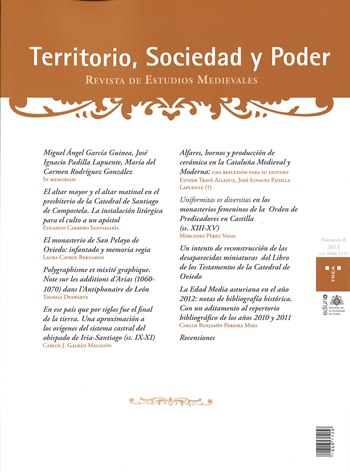Resumen
Resumée: Durant les années 1060/1070, des additionssont ajoutées en cursive wisigothique sur plusieurs foliosintroductifs de l’Antiphonaire de León, et un nouveaucahier écrit en minuscule y est inséré (fol. 20-27). Cesajouts, qui traitent tous de computistique, émanent peutêtred’une seule et même personne dénommée Arias.Cette hypothèse est renforcée par l’existence d’autrescas de polygraphisme déjà mis en évidence et qui nes’accompagnent jamais de contaminations entre lesécritures. A l’issue de cette analyse, nous proposons donccette hypothèse: polygraphisme et mixité graphique sontdeux réalités distinctes et contradictoires.Mots-clé: Paléographie. Écriture wisigothique. León. XIesiècleAbstract: (Polygraphism and graphic mixity. Note aboutArias’ additions (1060-1070) in the Antiphonary of León).The Antiphonary of León is a manuscript composed in themiddle of the 10th century, perhaps in the monastery ofSantiago of León. It is constituted by 306 folios divided in twoparts: introductory folios (f° 1-27) and the antiphonary itself.During the 1060’s, some texts in visigothic cursive are addedon several introductory folios, and a new quire in minusculeis inserted (fol. 20-27). In this two cases, the copyist give hisname: Arias. This additions may proceed from two diferentpersons, because there are indeed two Arias during this years:Arias Díaz, main «notarius» of the king during the 1060’s, andArias Vimaraz, procurator of Santa María’s chapter in Leónduring the 1070’s. But there is maybe only one copyist behindthis two scripts, in particular because this texts are all aboutcomputistic. Moreover, the copyist is more probably Arias Díaz,because of his status of «notarius regis» and the chronology ; inthis case, this identification would confirm the close relationshipbetween the kingship and the antiphonary of León in themiddle of the 11th century.We know others copyists who are able to write several scripts, forexample Vigila, who writes in 974-976 his famous manuscriptEscorial D-I-2 in minuscule, cursive and litterae elongatae. Infact, this polygraphism - that is the ability for one person to useseveral scripts -, is more widespread than we thought before;but it seems to cause rarely contaminations between writings: inSahagún, Munio’s minuscule never influenced his cursive. Onthe other hand, graphic mixity, that is the mixing by one handof letters coming from different alphabets, prove the porosityof a script, when his ‘monograph’ copyist is under pressurefrom another script, which he doesn’t master. Graphic mixityis characteristic of period of graphic transition, for example inCatalonia during the 9th century, when frankish script increaselittle by little at the expense of visigothic writing. In this respect,a small note in the Antiphonary (f° 12r), which can’t proceedfrom Arias, is written in a visigothic cursive influenced byminuscule. On the other hand, about 1100, the adoption offrench writing causes less graphic mixity than polygraphism and‘multigraphism’, that is the coexistence in one scriptorium ofcopyists using each one a different script (as in San Vicente deOviedo, where two monks write respectively in visigothic andcaroline).By studying additions of Arias in the introductory folios of theAntiphonary of León, and other cases of ‘polygraphism’ andgraphic mixity, we state that, in most of the cases, one copyisthas got as many scripts as alphabets, but no more. Only fewpolygraph copyists use very punctually a mixted script, as inMonte Cassino during the 11th century. Usually, mixed writingis not the third writing of a copyist mixing two alphabets whichhe masters perfectly: it is the only script of one copyist, whoseprincipal alphabet is under pressure from another script, whichhe masters imperfectly. So our hypotesis is that, during the EarlyMiddle Ages, polygraphism and graphic mixity are most of thetime two different and contradictory realities.Keywords: Paleography - visigothic script - León - XIth c.Descargas
Los datos de descargas todavía no están disponibles.

